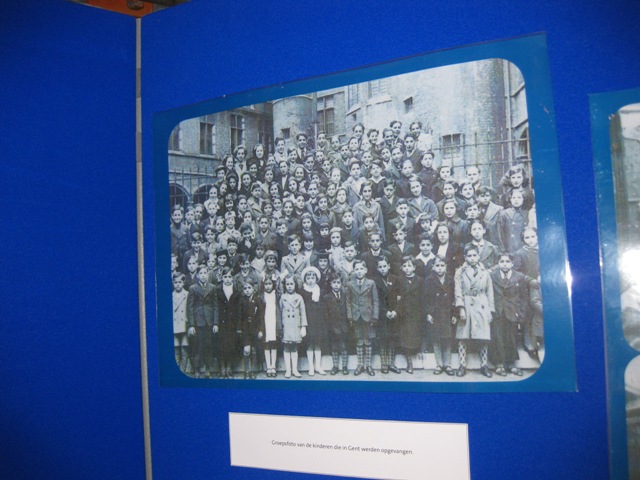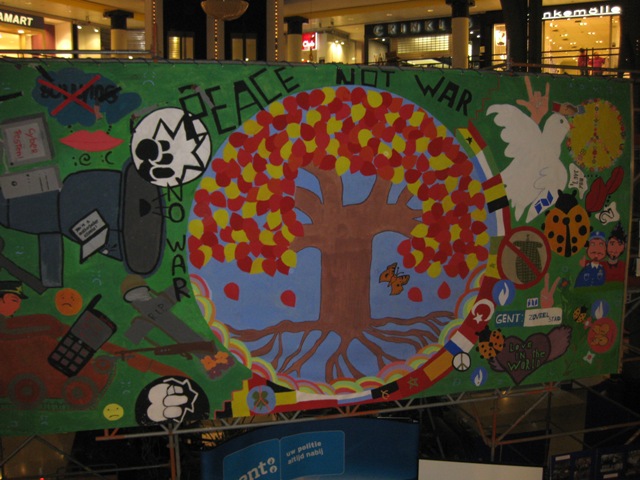Ghent, Belgium: dialogue between police and youth 2010
Ghent in Belgium is known to be an open and friendly city. It has alone 60 000 students and therefore is one exception to the rule of cities in Belgium, namely of not knowing racial tension or conflicts such as experienced in Brussels.
As to the overall situation in Belgium, it is not good. Like many other EU member states, Belgium is 100% in debt. That is not the only reason why governance is cumbersome. Besides that deficit there has to be added the fact that both the French and Flemish community keep the federal structure literally impoverished. At the same time, these communities are doing by themselves quite well, financially, socially and culturally speaking.
Flemish Cultural Contact Point
The contact for Kids' Guernica to Ghent came about thanks to Gudrun Heymans from the Flemish Cultrural Contact Point. She had heard that there is a project ongoing in Ghent. It has to do with Guernica 1937. Altogether 200 children were evacuated from there to Ghent. The person to contact is Manuel Gonzales.
Living in the Shadow of Guernica

Children from Guernica after arrival in Ghent
The father of Manuel Gonzales was one of the 200 children which came to Ghent. He adds that this city has always been open to newcomers and he maintains that the city has kept that tradition of being friendly to the other(s). This may explain why the city does not experience the same racial tensions leading on to bursts of violence as do other cities in Belgium like Brussels or even to some extent in Antwerpen.
Police of Ghent
Since Manuel Gonzales works for the Ghent police, the police of Ghent as institution and organisation has become involved in the Kids' Guernica project. The idea was to enter a dialogue between police and youth about violence in the city. As the project idea matured, it was naturally modified.
The police in dialogue with the youth
The Kids' Guernica project in Ghent is about the need for interaction between police and youth. Not to see respectively the other as just an enemy means to strive for a better understanding of what every side needs, namely an appreciation of the work done and the pain which goes with growing up in a society not at all sure as to what it wants from its future generation.
The broader theme of such dialogue between police and youth can be related to in the way participants of the 'Myth of the City' held in Crete 1995 discussed already with the youth the topic of 'violence in and against the city':
It can be linked as well as to what the artist Savina Tarsitano experienced when she undertook a Kids' Guernica action in Martinique. There she used the action of painting together with a youth calling itself the 'Baghdad gang' on a canvas the same size as Picasso's Guernica (7,8 x 3,5 m) to bridge the gap between them and the cultural centre. The aim was to integrate them insofar as other cultural tools used by the Centre had failed in this regard.
Kids' Guernica actions are about finding the right messages and cultural tools to include rather than exclude the youth from their own future development. For this can help as well the development of civic pride and a further understanding of what it takes to live in a peaceful society.
As events in Kyrgyzstan in June 2010 show, a life free of violence and suppression is never self-understood. In Kzrgyzstan ethnic violence has erupted to kill at least 100 people and wounding 1000s more. According to one eye witness visiting the area, it has forced the children to stay in the corridors of a hospital. When asked why they ended up there, they replied simply because their grandmother is a nurse and the only one capable of providing some protection. Their own kindergarten has been closed due to the violent clashes.
As there has been written a lot about police as organisation, it means to involve such an organisation in a Kids' Guernica action is but to acknowledge this reality in need of a dialogue between youth and police. One particular aim would be to reduce the enemy picture prevailing more often in the minds of both sides with the police demanding a sign of respect while the youth will always be inclined to test whenever possible the limits drawn for society at large by the police.
Concept by the Police of Ghent for the two Kids' Guernica actions
Dieter Dieussaert from the educational department explains that for the police it is important to be in contact with children and youth. Amazing is what preconception of policemen they have. When asked what distinguishes a policeman, then the children think mostly first of him carrying a gun and then secondly of someone ready to use pepperspray. Even though there are hardly any shootings in Ghent, save the recent incidence of two judges being shoot in the court room, it is amazing for the police that children have this notion about the police.
What the police wishes to bring across is that police work is first of all about talking with people, to stay in touch with reality, to be informed. Everytime there is a call for the police, it is important for them to seize up the situation and they can do so only if they do not take sides but appraise the situation as fair and just as possible. This is especially important when entering a night bar where a fight had broken out. Talking is therefore a matter of relating in an intelligent way to the situation.
For police work to be effective, this appraisal has to be ongoing and always substantiated by talking with the people. Usually people complain about the police never being there when needed or when called they do come but too late. In any case things cannot be resolved without relating to the situation and to the people who are directly involved. Like doctors so the police is exposed daily and continuously to the darker sides of society. Hence those in need of psychological counselling, they do get it especially after a shoot out. It is not easy to take if they arrive at a scene where a eleven year old has just committed suicide. The terrible pain of a society not at all harmonious and easy going is experienced by the police every day.

First mural by 6 to 12 year olds Ghent, Belgium June 2010
The second mural was done by High School students. Later on, when Kids' Guernica held a conference in Ghent on Feb. 18th, 2011, they stated that the experience had altered the relationships within the group. They felt having become able to give the others more space while the entire group was more open towards the outside world.

Press conference June 22, 2010
|
||||
|
||||
Kids’ Guernica
18/06/2010 – Politie Gent laat binnen het project Kids’ Guernica een enorm vredesschilderij maken. Op maandag 22, dinsdag 23 en woensdag 24 juni schildert een groep leerlingen van het IVV Sint Vincentius hun Kids’ Guernica op de binnenplaats van het gerechtsgebouw van Gent.
Kids' Guernica, een Japans initiatief, is een kunstproject met een internationale uitstraling waarbij kinderen of jongeren een vredestekening maken op een doek volgens de afmetingen van Picasso’s ‘Guernica’ (3,5m x 7,8m). Pablo Picasso schilderde zijn ‘Guernica’ als aanklacht tegen de brutaliteit van de bombardementen tijdens de Spaanse burgeroorlog van 1937. In 40 landen over de hele wereld zijn intussen meer dan 160 vredestekeningen geschilderd. Het is de allereerste keer dat een stad uit België deelneemt aan dit initiatief.
In de dagelijkse werking komt Politie Gent op tal van manieren in contact met jongeren. Met een actie als Kids’ Guernica kunnen we de dialoog tussen de jongeren en de politie versterken door hen uit te nodigen om samen met ons deze vredestekening te realiseren.
Dit is uniek in de wereld: in vele landen is de lokale politiemacht één van de grootste vijanden van de plaatselijke jongeren. “De dialoog tussen jongeren en politie kan voor de toekomst van Kids’ Guernica een belangrijke referentie worden,” aldus Dr. Hatto Fischer van het Kids’ Guernica Internationaal Comité.
We stelden de leerlingen de vraag “Wat kan de politie doen om geweld te voorkomen?” en hielpen hen met een politiebezoek het begrip geweld te interpreteren. Voor de invulling van het doek krijgen de jongeren de volledige vrijheid. We vragen enkel dat ze – met een eigen artistieke invulling – de logo’s van Politie Gent, Stad Gent en de Vlinder van de vzw Zinloos Geweld in de tekening opnemen.
In het najaar wordt het schilderij in Gent tentoongesteld.
Bericht aan de pers:
Graag nodigen we jullie op dinsdag 22 juni uit voor een persmoment.
Datum: dinsdag 22 juni
Uur: 11.00 uur
Plaats: Gerechtsgebouw, Opgeëistenlaan 401 a, 9000 Gent
Sprekers: Schepen van Onderwijs Rudy Coddens, waarnemend voorzitter Jan Cammaert en hoofdcommissaris Steven De Smet.
Dossier in behandeling bij:
Directie Externe Relaties
09/266 66 22
Information about the exhibition opening
Exhibition in November 2010 -
opening Nov. 10th preceding Nov. 11th marked in Belgium and especially in the area of Ghent as the ending of First World War.
The exhibition shall close on November 22nd to coincide with the International Day dedicated to Children's Rights.

Mural of the older girls
Documentation
There has been made an excellent film to give a full account of both the children which came from Guernica to Ghent and how the two murals emerged out of this story after Manuel Gonzales came into contact with Kids' Guernica.
|
KINDEREN VAN GUERNICA is een voorbeeld van werken met digitaal archief in de klas. |
||
|
|
||
Contacts:
Police of Ghent
Chief Commissioner: Steven De Smet Steven and Officier Dieussaert Dieter
Police Department of Communication: Kim Convent
Verantwoordelijke secretariaat
Politiezone Gent | Directie Externe Relaties
Zandberg 4 | 9000 Gent | 09/266 66 35
Kim.Covent@politie.gent.be
www.politiegent.be
To keep everyone posted on our day-to-day progress with the first Belgian Kids’ Guernica, there shall be maintained a weblog (in Dutch): http://politiegent-kidsguernica.blogspot.com
Manuel will be the contact person concerning international aspects of the project.
Manuel Mugica-Gonzalez
Perzikstraat 12
9000 Gent
tel: 00.32.477.31.94.47
manuel.mugicagonzalez@politie.gent.be
« Youth in Wedding - Berlin 2010 | Mural by the youth »
